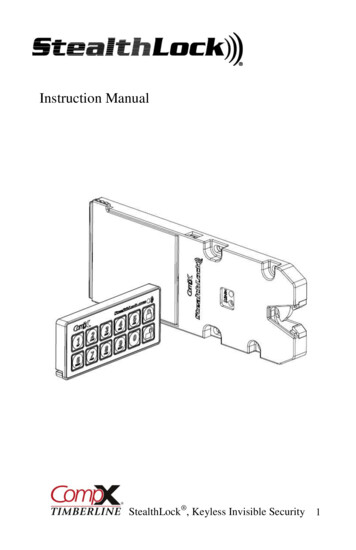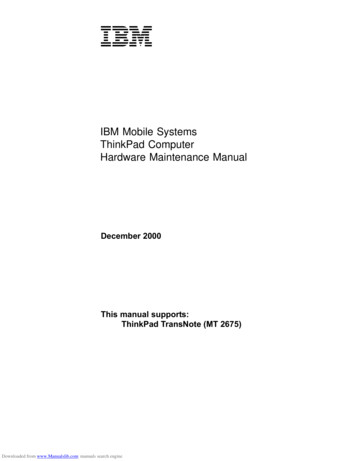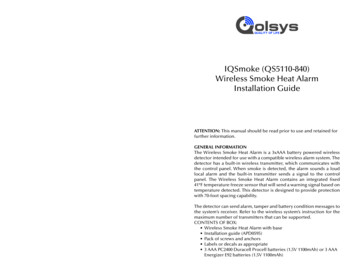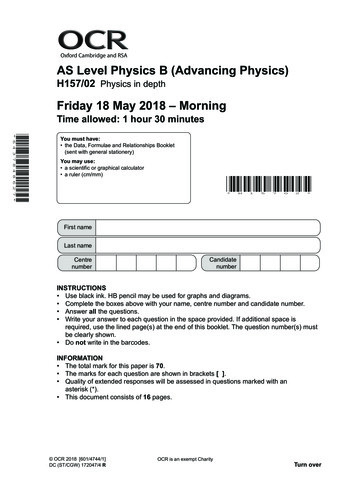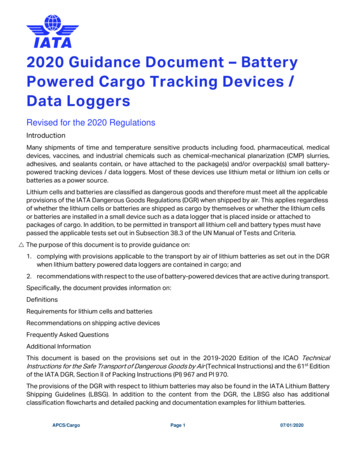
Transcription
2020 Guidance Document – BatteryPowered Cargo Tracking Devices /Data LoggersRevised for the 2020 RegulationsIntroductionMany shipments of time and temperature sensitive products including food, pharmaceutical, medicaldevices, vaccines, and industrial chemicals such as chemical-mechanical planarization (CMP) slurries,adhesives, and sealants contain, or have attached to the package(s) and/or overpack(s) small batterypowered tracking devices / data loggers. Most of these devices use lithium metal or lithium ion cells orbatteries as a power source.Lithium cells and batteries are classified as dangerous goods and therefore must meet all the applicableprovisions of the IATA Dangerous Goods Regulations (DGR) when shipped by air. This applies regardlessof whether the lithium cells or batteries are shipped as cargo by themselves or whether the lithium cellsor batteries are installed in a small device such as a data logger that is placed inside or attached topackages of cargo. In addition, to be permitted in transport all lithium cell and battery types must havepassed the applicable tests set out in Subsection 38.3 of the UN Manual of Tests and Criteria. The purpose of this document is to provide guidance on:1. complying with provisions applicable to the transport by air of lithium batteries as set out in the DGRwhen lithium battery powered data loggers are contained in cargo; and2. recommendations with respect to the use of battery-powered devices that are active during transport.Specifically, the document provides information on:DefinitionsRequirements for lithium cells and batteriesRecommendations on shipping active devicesFrequently Asked QuestionsAdditional InformationThis document is based on the provisions set out in the 2019-2020 Edition of the ICAO TechnicalInstructions for the Safe Transport of Dangerous Goods by Air (Technical Instructions) and the 61st Editionof the IATA DGR, Section II of Packing Instructions (PI) 967 and PI 970.The provisions of the DGR with respect to lithium batteries may also be found in the IATA Lithium BatteryShipping Guidelines (LBSG). In addition to the content from the DGR, the LBSG also has additionalclassification flowcharts and detailed packing and documentation examples for lithium batteries.APCS/CargoPage 107/01/2020
IATA Battery Powered Data Logger Guidance Document – 2020The recommendations for active devices are taken from advisory information produced by the EuropeanAviation Safety Authority (EASA), AMC1 CAT.GEN.MPA.140 – Portable Electronic Devices and the USFederal Aviation Administration (FAA) Advisory Circular AC 21.91-1D – Use of Portable ElectronicDevices Aboard Aircraft. Much of the information in this guidance document related to the conditionsthat apply to data loggers and cargo tracking devices in or attached to cargo carried in aircraft cargocompartments is taken from Section 10 of FAA Advisory Circular AC 21.91-1D.Information on the DGR and LBSG can be found sgDefinitionsLithium Battery – The term “lithium battery” refers to a family of batteries with different chemistries,comprising many types of cathodes and electrolytes. For the purposes of the DGR they are separatedinto:Lithium metal batteries. Are generally primary (non-rechargeable) batteries that have lithium metal orlithium compounds as an anode. Also included within lithium metal are lithium alloy batteries. Lithiummetal batteries are generally used to power devices such as watches, calculators, cameras, temperaturedata loggers, car key fobs and defibrillators. Note:Lithium metal batteries packed by themselves (not contained in or packed with equipment) (PackingInstruction 968) are forbidden for transport as cargo on passenger aircraft). In accordance with SpecialProvision A201, lithium metal cells or batteries that meet the quantity limits of Section II of PI 968 may beshipped on a passenger aircraft under an approval issued by the authority of the State of Origin, State ofDestination and State of the Operator. All other lithium metal cells and batteries can only be shipped on apassenger aircraft under exemption issued by all States concerned, see Special Provision A201.Figure 1 - Example of Lithium Metal Cells and BatteriesAPCS/CargoPage 207/01/2020
IATA Battery Powered Data Logger Guidance Document – 2020Lithium-ion batteries (sometimes abbreviated Li-ion batteries) are a secondary (rechargeable) batterywhere the lithium is only present in an ionic form in the electrolyte. Also included within the category oflithium-ion batteries are lithium polymer batteries. Lithium-ion batteries are generally used to powerdevices such as mobile telephones, laptop computers, tablets, power tools and e-bikes.Figure 2 - Example of Lithium Ion Cells and Batteries Note:Lithium ion batteries packed by themselves (Packing Instruction 965) (not contained in or packed withequipment):(a) must be shipped at a state of charge (SoC) not exceeding 30% of their rated design capacity. Cellsand/or batteries at a SoC of greater than 30% may only be shipped with the approval of the State ofOrigin and the State of the Operator under the written conditions established by those authorities, seeSpecial Provision A331; and(b) may be shipped as cargo on a passenger aircraft under an approval issued by the authority of the Stateof Origin, State of Destination and State of the Operator where the lithium ion cells or batteries that meetthe quantity limits of Section II of PI 965. All other lithium ion cells and batteries can only be shipped ascargo on a passenger aircraft under exemption issued by all States concerned, see Special ProvisionA201. Aggregate lithium content means the sum of the grams of lithium content contained by the cellscomprising a battery.The technical definition of a battery and cell, as indicated in the UN Manual of Tests and Criteria, is asfollows:Battery means two or more cells which are electrically connected together and fitted with devicesnecessary for use, for example, case, terminals, marking and protective devices. Units which have two ormore cells that are commonly referred to as "battery packs", "modules" or "battery assemblies" havingthe primary function of providing a source of power to another piece of equipment are for thepurposes of the UN Model Regulations and this guidance document treated as batteries. See definitionsfor “cell” and “single cell battery”. (See also “Power Banks”)Button cell or battery means a round small cell or battery when the overall height is less than thediameter.Cell means a single encased electrochemical unit (one positive and one negative electrode) whichexhibits a voltage differential across its two terminals. Under the UN Model Regulations, UN Manual ofTests and Criteria and this guidance, to the extent the encased electrochemical unit meets the definitionof “cell” herein, it is a “cell”, not a “battery”, regardless of whether the unit is termed a “battery” or a“single cell battery” outside of the UN Model Regulations, the UN Manual of Tests and Criteria and thisguidance.APCS/CargoPage 307/01/2020
IATA Battery Powered Data Logger Guidance Document – 2020Consignment, one or more packages of dangerous goods accepted by an operator (airline) from oneshipper at one time and at one address, receipted for in one lot and moving to one consignee at onedestination address.Operator, a person, organisation or enterprise engaged in or offering to engage in an aircraft operation.Overpack, an enclosure used by a single shipper to contain one or more packages and to form onehandling unit for convenience of handling and stowage. Dangerous goods packages contained in theoverpack must be properly packed, marked, labelled and in proper condition as required by the DGR. (AUnit Load Device is not included in this definition).Package, (for dangerous goods) the complete product of the packing operation consisting of thepackaging and contents prepared for transport.Packaging, one or more receptacles and any other components or materials necessary for thereceptacles to perform their containment and other safety functions and to ensure compliance with theminimum packing requirements of the DGR.Unit Load Device (ULD), any type of freight container, aircraft container, aircraft pallet with a net, oraircraft pallet with a net over an igloo.Note:An overpack is not included in this definition.Watt-hour Rating, expressed in Watt-hours (Wh), the Watt-hour rating of a lithium cell or battery iscalculated by multiplying the rated capacity in ampere-hours by the nominal voltage. Classification (DGR 3.9.2.6)Lithium batteries are classified in Class 9 – Miscellaneous dangerous goods as: UN 3090, Lithium metal batteries; or UN 3480, Lithium ion batteriesor, if inside a piece of equipment or packed separately with a piece of equipment to power thatequipment as: UN 3091, Lithium metal batteries contained in equipment; or UN 3091, Lithium metal batteries packed with equipment; and UN 3481, Lithium ion batteries contained in equipment; or UN 3481, Lithium ion batteries packed with equipment.Lithium battery test summary – effective 1 January 2020, manufacturers and subsequent distributors ofcells or batteries and equipment powered by cells and batteries manufactured after 30 June 2003 mustmake available the test summary as specified in the UN Manual of Tests and Criteria, Revision 6 andamend. 1, Part III, sub-section 38.3, paragraph 38.3.5.Note:The requirement is for the manufacturer and subsequent distributors to make this test summary available.There are numerous ways this can be achieved, such as by listing the applicable summary document onthe company website. There is no expectation for the shipper/distributor to provide paper copies with eachconsignment containing lithium batteries. The supply chain are encouraged to make use of technology tofacilitate the availability of the test summary.APCS/CargoPage 407/01/2020
IATA Battery Powered Data Logger Guidance Document – 2020The following table provides details of the information required in the test summary:Lithium cell or battery test summary in accordance with sub-section 38.3 of Manual of Testsand CriteriaThe following information shall be provided in this test summary:(a) Name of cell, battery, or product manufacturer, as applicable;(b) Cell, battery, or product manufacturer's contact information to include address, phonenumber, email address and website for more information;(c) Name of the test laboratory to include address, phone number, email address and websitefor more information;(d) A unique test report identification number;(e) Date of test report;(f) Description of cell or battery to include at a minimum:(i) Lithium ion or lithium metal cell or battery;(ii) Mass;(iii) Watt-hour rating, or lithium content;(iv) Physical description of the cell/battery; and(v) Model numbers.(g) List of tests conducted and results (i.e., pass/fail);(h) Reference to assembled battery testing requirements, if applicable (i.e. 38.3.3 (f) and38.3.3 (g));(i) Reference to the revised edition of the Manual of Tests and Criteria used and toamendments thereto, if any; and(j) Signature with name and title of signatory as an indication of the validity of informationprovided.Further information on the test summary and FAQ’s is available in Part 4 of this guidance document.Requirements for Lithium Cells and BatteriesThe extent to which the lithium cells or batteries are regulated as dangerous goods depends on:(a) the lithium metal content for lithium metal cells or batteries; or(b) the Watt-hour (Wh) rating for lithium ion cells or batteries.Fully Regulated Lithium BatteriesLithium metal cells with a lithium metal content exceeding 1 g and lithium metal batteries with a lithiummetal content exceeding 2 g.Lithium ion cells with a Watt-hour rating exceeding 20 Wh and lithium ion batteries with a Watt-hourrating exceeding 100 Wh.Devices that contain fully regulated lithium cells or batteries are subject to all of the provisions of theDGR, which includes:(a) dangerous goods training. All persons involved in the preparation and shipping must have completedappropriate dangerous goods training and must attend recurrent dangerous goods training atintervals not exceeding 24 months;APCS/CargoPage 507/01/2020
IATA Battery Powered Data Logger Guidance Document – 2020(b) marks and labels on packages. All packages must be marked with the name and address of theshipper and consignee, the UN number and proper shipping name. Packages must also bear theClass 9 lithium battery hazard label;(c) documentation. The consignment must be correctly described on a Shipper’s Declaration forDangerous Goods.Excepted Lithium BatteriesWhere the lithium cells or batteries have a lithium metal content of 1 g or less for cells or 2 g or less forbatteries or for lithium ion the cells have a Watt-hour rating of 20 Wh or less or batteries are 100 Wh orless, then they are not subject to all of the provisions of the DGR.Lithium cells or batteries that fit within these limits are subject to Section II of the applicable lithiumbattery packing instructions in the DGR. Each package that contains such cells or batteries, includingthose installed in devices, must not contain more than 5 kg net weight of lithium cells or batteries.Cargo Tracking Devices / Data Loggers Containing Excepted Lithium cells or BatteriesPackages containing lithium batteries installed in equipment such as a data logger must bear the lithiumbattery mark as shown in Figure 7.1.C of the IATA DGR, see Figure 3. The border of the label must havered diagonal hatchings 5 mm in width with text and symbols in black on a white or contrasting background.The lithium battery mark may be printed directly on the outer packaging provided that there is sufficientcontrast between the elements of the lithium battery mark and the colour of the packaging material. Theminimum dimensions are 120 mm wide x 110 mm high.Exceptions:1. the lithium battery mark is not required on packages where the data loggers are powered by onlybutton (coin) cells (regardless of the quantity of data loggers in a particular package or the number ofpackages in a consignment);2. the lithium battery mark is not required on packages where there are no more than 4 cells or 2batteries contained in equipment in each package and there are no more than two packages in theconsignment.This means that if the cargo tracking device or data logger is powered by other than lithium button (coin)cells and there are more than two packages containing tracking devices/data loggers, then the lithiumbattery mark must be applies to all packages in the consignment that contain tracking devices/dataloggers.APCS/CargoPage 607/01/2020
IATA Battery Powered Data Logger Guidance Document – 2020Figure 3 – Lithium Battery Mark* Place for UN number(s), i.e. UN 3090, UN 3091, UN 3480 and/or UN 3481, as applicable** Place for telephone number Where the packages are of dimensions such that they cannot bear the full-size lithium battery mark, themark dimensions may be reduced to 105 mm wide 74 mm high. The design specifications otherwiseremain the same.The telephone number on the lithium battery mark should be that of a person knowledgeable about theshipment but is not intended to be for the purposes of obtaining immediate emergency responseguidance, and is therefore not required to be monitored at all times while the package is in transit. It isacceptable for the number to be monitored during the company’s normal business hours in order toprovide product-specific information relative to the shipment. However, it also is acceptable to use anemergency response, 24-hour phone number on the lithium battery mark.Where a consignment includes packages bearing the lithium battery mark, the words “Lithium ionbatteries in compliance with Section II of PI 967” or “Lithium metal batteries in compliance with Section IIof PI 970”, as applicable must be included on the air waybill, when an air waybill is used. The informationshould be shown in the “Nature and Quantity of Goods” box of the air waybill.Note:A Shipper’s Declaration for Dangerous Goods is not required.Shippers of excepted lithium batteries are not subject to the formal dangerous goods trainingrequirements set out in DGR 1.5, however, persons preparing such shipments must be provided with“adequate instruction” as described in DGR 1.6.The following is offered as a starting point for an employer on what could be considered as being adequateinstruction:APCS/CargoPage 707/01/2020
IATA Battery Powered Data Logger Guidance Document – 20201. The employer must identify the different configurations of lithium batteries that they ship, i.e. lithiumbatteries and/or lithium batteries packed with equipment and/or lithium batteries contained inequipment; lithium metal batteries and/or lithium ion batteries.2. The employer must document the procedures that apply to the configurations and battery types thatthey ship as determined in 1, above.3. The procedures should be written up as a clear work instructions or other form of information that isavailable to all employees responsible for the preparation of lithium battery shipments.4. All employees that are involved in the process of preparing lithium battery shipments must be takenthrough the procedure to ensure that they understand and can demonstrate the correct applicationof documented procedures for the packing, labelling, marking and documentations requirements, asapplicable to their job function.5. A record must be maintained that identifies each applicable employee and the date(s) that thisinstruction was provided.6. Employees should be given periodic refresher, or at least demonstrate that they remain “adequately”instructed on how to perform the task. This should be done at least every two years or whenever theprocedure is revised, or regulations are changed, whichever is sooner.7. Companies that are involved in reverse logistics, i.e. arranging for returns of lithium batteries, lithiumbatteries packed with equipment or lithium batteries contained in equipment must develop a clearinstruction for consumers on the process to be followed for returning products. This instruction mustinclude packaging materials and lithium battery marks, as necessary. The instruction must also includethe transport method and mode of transport to be followed; this must include a clear statement onapplicable prohibitions. Recommendations on Shipping Active Devices (Extract from FAA AC 91.21-1D)Portable electronic devices (PED) such as data loggers and cargo tracking devices, that are designed toremain active throughout their entire transport from the shipper to the consignee, including when onboard an aircraft, have the potential to interfere with aircraft navigation or communication systems.Therefore, manufacturers of PED, users of PED and the operator (airline) are only permitted to place in orattach to cargo and to carry PED that the operator of the aircraft has determined will not interfere withthe safe operation of that aircraft. The recommendations set out in this document are one means, butnot the only means, of complying with the applicable operational regulations pertaining to the operationof PED.This section applies to PED that are designed for use on aircraft in locations inaccessible to the flightcrew during flight. Because this class of PED cannot be turned off manually in the event of anemergency, the device manufacturers and aircraft operators must ensure certain design and operationalconsiderations are addressed. The operator must ensure that these PED meet the following criteria priorto allowing use on aircraft:1. during all modes of operation, the cargo tracking device / data logger meets the RF radiatedemissions limits defined in RTCA DO-160, Environmental Conditions and Test Procedures forAirborne Equipment, Section 21, Category H. Testing of the device must include any peripheraldevices that will be used with the device during normal operations. Typically, peripherals includeexternal sensors or associated wiring. For additional Guidance, refer to RTCA/DO-357, User Guide:Supplement to DO-160G.APCS/CargoPage 807/01/2020
IATA Battery Powered Data Logger Guidance Document – 20202. if the test described in subparagraph 1. fails or is not met, then the device must be designed with aminimum of two independent means to turn off completely, turn off cellular or mobile functions, or acombination of both when airborne. These independent methods must use different sources toidentify flight. For example, a cargo tracking device designed to sense rapid altitude changes andacceleration to turn off cellular transmissions is an acceptable design feature that meets therequirement. Redundant sources of the same information, such as two vertical accelerometers,would not be an acceptable design.3. The device may use low-powered wireless communications during flight without the need to complywith subparagraph 1. This includes Bluetooth (IEEE 802.15.1), ZigBee (IEEE 802.15.4).4. the device manufacturer substantiated data includes:(a) pictures of the device and any peripherals,(b) product label,(c) operational description of device and peripherals,(d) manufacturer statement of strict design and production controls, and(e) if device contains a lithium battery, battery design standard and relevant battery qualificationdocumentation (e.g., TSO-C142a, Non-Rechargeable Lithium Cells or Batteries, dated August 7,2006, approval; RTCA/DO-311, Minimum Operational Performance Standards for RechargeableLithium Battery Systems, dated March 13, 2008, qualification report, maintenance requirementsand process and procedures to address the movement of defective devices, including damagedor defective batteries).5. the device must not be capable of generating a dangerous evolution of heat.6. the device must not be capable of emitting disturbing signals, such as buzzing alarms or strobe lights,during transport.Manufacturers of cargo tracking devices/data loggers should undertake all of the required testing of theirdevices so that they can satisfy the aircraft operator that the devices comply with the recommendationsabove. It is recommended that the device manufacturers coordinate with the aircraft operators so that alist of approved devices is available to users of the devices.It is the operator that retains the responsibility to approve the use and carriage of PED in cargo and it isthe operator that will issue any authorisation or approval on the use of PED on their aircraft.It is recommended that manufacturers of PED that are intended to be placed into, or attached to cargomake contact with operators in advance so that the approval / authorisation can be coordinated. This willavoid the need for multiple individual shippers to seek approval / authorisation for the same device.APCS/CargoPage 907/01/2020
IATA Battery Powered Data Logger Guidance Document – 2020Frequently Asked QuestionsPart 1 – Questions Related to DefinitionsA. What are the various types of lithium batteries?Lithium batteries fall into two broad classifications; lithium metal batteries and lithium ion batteries.Lithium metal batteries are generally non-rechargeable and contain metallic lithium. Lithium ion batteriescontain lithium which is only present in an ionic form in the electrolyte and are rechargeable.Within these two broad classifications there are many different chemistries. For example within lithiumion batteries there are lithium polymer, lithium iron phosphate (LiFePO4), lithium air to name a few.B. What is the difference between a lithium cell and a lithium battery?A lithium cell is a single encased electrochemical unit consisting of one positive and one negativeelectrode that exhibits a voltage differential across the two terminals. A lithium battery is two or morecells electrically connected. A single cell battery is considered a cell and not a battery for the purposesof the limitations set out in the DGR.Note: Units that are commonly referred to as “battery packs” or “power banks” having the primaryfunction of providing a source of power to another piece of equipment are for the purposes of theseRegulations treated as batteries. Refer to the section on Definitions for complete details.C. How are component cells connected to form a battery?Cells in batteries may be connected in parallel, in series, or in a combination of the two. When cells areconnected in series, the voltage of the battery increases but the capacity in ampere-hours (Ah) does notchange. By contrast, when cells are connected in parallel the capacity in ampere-hours of the battery(Ah) increases but the voltage stays the same.D. How do I determine the watt-hour rating for a particular lithium ion battery?The watt-hour (Wh) rating is a measure by which lithium ion batteries are regulated. Section I Lithium ionbatteries manufactured after 31 December 2011 and Section IB and Section II Lithium ion batteriesmanufactured after 1 January 2009 are required to be marked with the watt-hour rating.You can also arrive at the number of watt-hours your battery provides if you know the battery’s nominalvoltage (V) and capacity in ampere-hours (Ah):Ah x V WhNote:If only the milliampere-hours (mAh) are marked on the battery then divide that number by 1000 to getampere-hours (Ah) (i.e. 4400 mAh / 1000 4.4. Ah).Most lithium ion batteries marketed to consumers are below 100 watt-hours. If you are unsure of thewatt-hour rating of your lithium ion battery, contact the manufacturer.E. What is a button cell battery?A button cell battery is a round small cell where the overall height is less than the diameter. Button cells areoften referred to as “coin” cells.APCS/CargoPage 1007/01/2020
IATA Battery Powered Data Logger Guidance Document – 2020Part 2 – Questions Related to Design Type Testing ProvisionsA. Where can I find requirements related to testing of battery design types?The UN Manual of Tests and Criteria sets out specific tests that must be conducted on each lithium cellor battery design type. Each test is intended to either simulate a common transportation occurrencesuch as vibration or changes in altitude or to test the integrity of a cell or battery. You may obtain a copyof these testing requirements via the following nual/manual e.html.B. What constitutes a design change requiring renewed design type testing?The following provisions are taken from the 6th revised edition, Amend. 1 of the UN Manual of Tests andCriteria, paragraph 38.3.2.2.A cell or battery that differs from a tested design by:(a) For primary cells and batteries, a change of more than 0.1 g or 20% by mass, whichever is greater, tothe cathode, to the anode, or to the electrolyte;(b) For rechargeable cells and batteries, a change in Watt-hours of more than 20% or an increase involtage of more than 20%; or(c) A change that would materially affect the test results.shall be considered a new type and shall be subjected to the required tests.Note: the type of change that might be considered to differ from a tested type, such that it might lead toa failure of any of the test results, may include, but is not limited to:(a) A change in the material of the anode, the cathode, the separator or the electrolyte;(b) A change of protective devices, including the hardware and software;(c) A change of safety design in cells or batteries, such as a venting valve;(d) A change in the number of component cells;(e) A change in connection mode of component cells;(f) For batteries which are to be tested according to T.4 with a peak acceleration less than 150 gn, achange in the mass which could adversely impact the result of the T.4 test and lead to a failure.In the event that a cell or battery type does not meet one or more of the test requirements, steps shallbe taken to correct the deficiency or deficiencies that caused the failure before such a cell or batterytype is retested. C. Who is responsible for testing lithium cells and batteries?It is the manufacturer of the lithium cell type to have the type tested against the applicable provisions setout in Subsection 38.3 of the UN Manual of Tests and Criteria. In addition where lithium cells arecombined together to form a battery, the manufacturer of the lithium battery must have the battery typetested against the applicable provisions set out in Subsection 38.3 of the UN Manual of Tests andCriteria.Manufacturers of devices that incorporate lithium cells or batteries are required to make available a copyof the test summary for the lithium cells or batteries, see Part 4 of this guidance for more detail.APCS/CargoPage 1107/01/2020
IATA Battery Powered Data Logger Guidance Document – 2020Part 3 – Questions related to Packaging and Transport ProvisionsA. If I have smaller packages, can I use a smaller lithium mark?Where the packages are of dimensions such that they cannot bear the full-size lithium battery mark, themark dimensions may be reduced to 105 mm wide 74 mm high. The design specifications remainotherwise the same.B. When is a lithium battery mark not required on the package?A lithium battery mark is not required for packages prepared in accordance with Section II of PI 967 orPI 970 containing only button cell batteries installed in equipment (including circuit boards) orconsignments of two packages or less where each package contains no more than four cells, or twobatteries installed in equipment.Note:The Air Waybill is only required to contain the statements "Lithium [ion or metal] batteries in compliancewith Section II of PI9XX" when the lithium battery mark is affixed to the package(s).C. Section II in Packing Instructions 967 and 970 states that “the lithium battery mark is not requiredon consignments of two packages or less where each package contains no more than four cells ortwo batteries installed i
IATA Battery Powered Data Logger Guidance Document - 2020 APCS/Cargo Page 3 07/01/2020 Lithium-ion batteries (sometimes abbreviated Li-ion batteries) are a secondary (rechargeable) battery where the lithium is only present in an ionic form in the electrolyte. Also included within the category of lithium-ion batteries are lithium polymer .



![Smarter Battery Crack [2022-Latest]](/img/13/eliamari.jpg)

